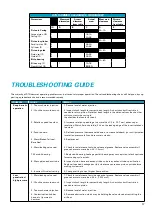
4
SAFETY
Follow instructions
Carefully read all safety messages in this manual and on your
machine´s safety labels. Keep safety labels in good condition.
Replace all missing or damaged safety labels.
Replacement safety labels can be obtained at no cost from
your local Atlas Copco dealer or representative or by contacting
the factory.
Learn how to operate the DTH hammer and how to use the
controls on the machine properly. Do not let anyone operate this
DTH hammer without proper instruction.
If you do not understand any part of this manual and need
assistance, contact your local Atlas Copco dealer.
Keep the DTH hammer in good working
condition
Keep your DTH hammer in proper working condition.
Unauthorized modifications to the DTH hammer may impair the
function and/or safety and effect the DTH hammer life.
Make sure all safety devices, including shields are installed and
functioning properly.
Visually inspect the DTH hammer daily before using. Do not
operate the DTH hammer with loose, worn or broken parts.
Wear protective clothing
Wear APPROVED safety equipment (safety shoes, safety glasses,
hearing protection, hard hat, gloves, respirator, etc.) when
operating or maintaining the DTH hammer .
Wear close fitting clothing and confine long hair.
Operating equipment requires the full attention of the operator.
Do not wear radio or music headphones while operating the DTH
hammer.
Check for underground utility lines
Before starting work, remember that contact with buried utilities
may cause serious injury or death. Electric line contact may
cause electric shock or electrocution. Gas line contact may
rupture pipe causing explosion or fire. Fiber optic cables can
blind you if you look into the laser light in them. Water line
rupture may cause a flood and possible ground collapse. Before
drilling, check with qualified sources to properly locate all buried
utilities in and around drill path. Select a drill path that will not
intersect buried utilities. Never launch a drill bit on a path
toward electric, gas, or water lines until their location is known.
If there is any doubt as to the location of the underground
placement, have the utility company shut it off before starting
any underground work and excavate to confirm its exact
location.
Warning symbols
Be aware of safety information.
A warning symbol - DANGER, WARNING, or CAUTION - is
used with the safety-alert symbol. DANGER identifies the most
serious hazards.
Indicates immediate hazards which WILL result in serious or
fatal injury if the warning is not observed.
DANGER
Indicates hazards or hazardous procedures which COULD
result in serious or fatal injury if the warning is not
observed.
WARNING
Indicates hazards or hazardous procedures which COULD
result in injury or damage to equipment if the warning is not
observed.
CAUTION
Avoid electrocution - stay away
Electrocution possible. Serious injury or death may result if
the machine strikes an energized powerline. Take the following
precautions to prevent electrocution. Also refer to the operating
instructions.
•
Always contact your local utility company when working in
the vicinity of utilities.
•
Locate underground utilities by qualified persons.
•
Do not raise, lower or move drill guide or boom near power
lines.
•
Always wear proper electrically insulated linemanís gloves
and boots.
•
Never touch metal parts on machine while standing on bare
ground if machine comes in contact with a powerline.
•
Always stay in cab during all drilling operations.
•
Never step onto or off of a machine if an electric strike
occurs.
Loose parts
Make sure the drill rod to rotary head spindle joint is securely
tightened before running the rotary head in reverse rotation.
A loose connection could result in the drill rod unscrewing
completely; a falling drill rod could strike personnel.



















